Short Story and photos by Marks Hinton
It was dark as the Collector turned down the filthy alley off a back street in Port Moresby. Although he usually confined his purchases to Papuan art work that sold rapidly to interior decorators that frequented his boutique in San Francisco, the few who knew him well were aware of his taste for more exotic chef d’oeuvre for his private enjoyment. And because of the urgent message from the Merchant he was on his way to acquire this new treasure.
***
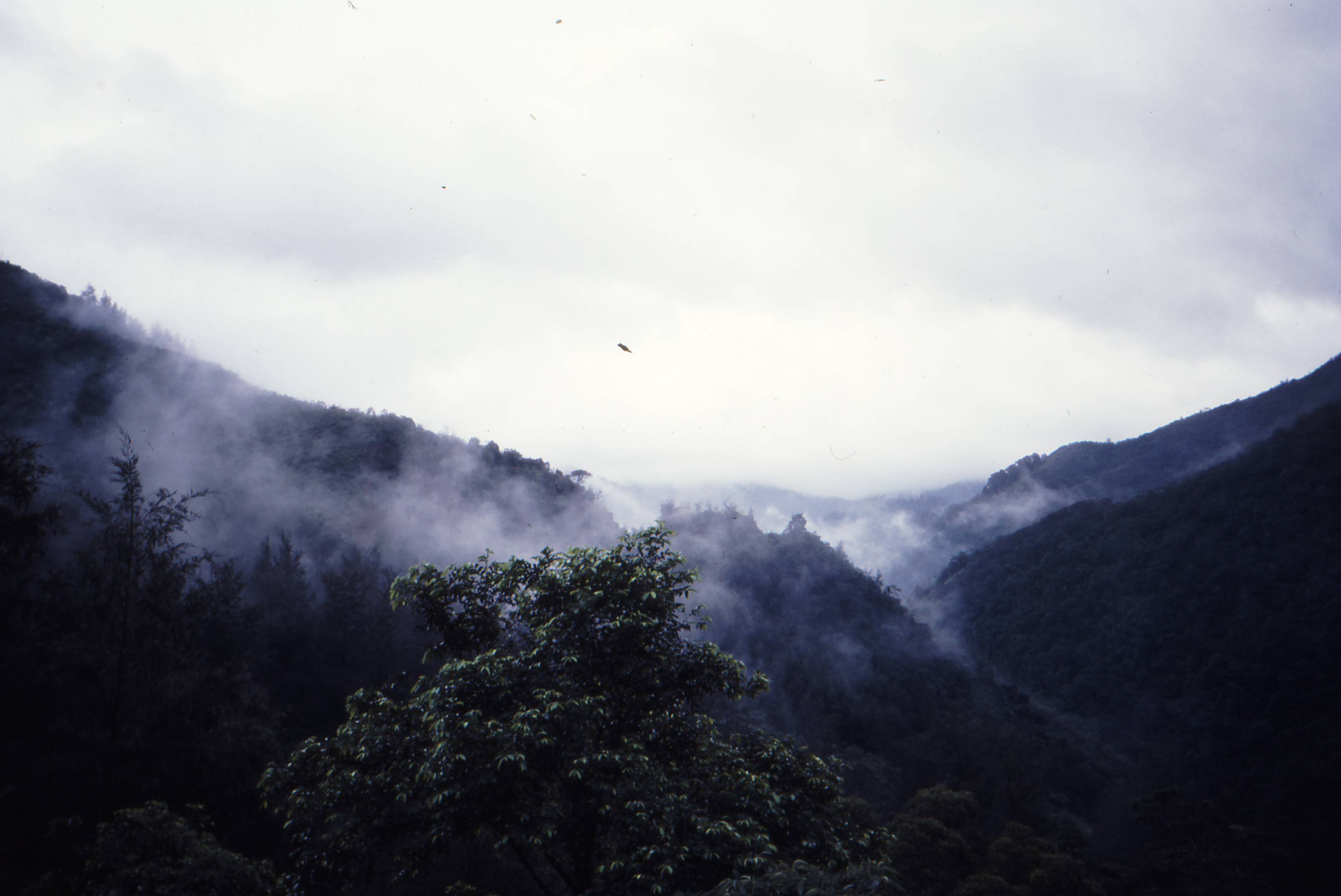 The Collector was in Moresby on his regular purchasing trip. Papua New Guinea’s primeval aura enveloped him the minute he stepped on the tarmac at the World War II vintage hangar that serves as this remote island’s international airport terminal. The dampness and bouquet of sickeningly sweet flowers oozed out of the jungle that surrounds the airfield. The air was fetid and filled with large mosquitoes that buzzed dangerously close to his exposed skin, seeking a target to give a visitor a lasting memory of this God-forsaken place – a dose of malaria or yellow fever. He walked quickly into the Quonset hut, slamming the tattered screen door behind him. He could not help wondering how these savages lived in this misty green Hell but then he recalled that PNG was only twenty years removed from the Stone Age.
The Collector was in Moresby on his regular purchasing trip. Papua New Guinea’s primeval aura enveloped him the minute he stepped on the tarmac at the World War II vintage hangar that serves as this remote island’s international airport terminal. The dampness and bouquet of sickeningly sweet flowers oozed out of the jungle that surrounds the airfield. The air was fetid and filled with large mosquitoes that buzzed dangerously close to his exposed skin, seeking a target to give a visitor a lasting memory of this God-forsaken place – a dose of malaria or yellow fever. He walked quickly into the Quonset hut, slamming the tattered screen door behind him. He could not help wondering how these savages lived in this misty green Hell but then he recalled that PNG was only twenty years removed from the Stone Age.
 The Collector was reminded of a walkabout he went on years ago to visit a small memorial to Allied troops who died on the Kokoda Trail of wounds and diseases during the Pacific campaign. On the path a near naked tribal man with wild boar tusks through his septum, headdress of bird of paradise feathers and a penis gourd materialized out of the jungle like a magic phantom. He carried a bow and arrow, long carved wooden spear and a stone ax. Startled at first, the Collector quickly realized this Stone Age visitor was more curious about him than intent on causing harm. As always the Collector carried, along with his pack and canteen, a machete and a small steel hatchet for hacking trails where the rapidly growing overgrowth recaptured its rightful place. The Man had never seen a metal tool before but clearly recognized the hatchet as a geometric improvement on his primitive ax. Despite being unable to converse in any common language, communication was established through a series of grunts, pointing and some primeval understanding of commerce. Within a short time the Man owned the steel hatchet and the Collector possessed a stone ax and a beautifully carved spear. Both went on their separate ways, each believing he had gotten the best of the deal. That ax with its musty odor from spending many nights in a smoked-filled, thatched Papuan jungle hut, is proudly displayed on a coffee table in the Collector’s luxury condominium on Lombard Street.
The Collector was reminded of a walkabout he went on years ago to visit a small memorial to Allied troops who died on the Kokoda Trail of wounds and diseases during the Pacific campaign. On the path a near naked tribal man with wild boar tusks through his septum, headdress of bird of paradise feathers and a penis gourd materialized out of the jungle like a magic phantom. He carried a bow and arrow, long carved wooden spear and a stone ax. Startled at first, the Collector quickly realized this Stone Age visitor was more curious about him than intent on causing harm. As always the Collector carried, along with his pack and canteen, a machete and a small steel hatchet for hacking trails where the rapidly growing overgrowth recaptured its rightful place. The Man had never seen a metal tool before but clearly recognized the hatchet as a geometric improvement on his primitive ax. Despite being unable to converse in any common language, communication was established through a series of grunts, pointing and some primeval understanding of commerce. Within a short time the Man owned the steel hatchet and the Collector possessed a stone ax and a beautifully carved spear. Both went on their separate ways, each believing he had gotten the best of the deal. That ax with its musty odor from spending many nights in a smoked-filled, thatched Papuan jungle hut, is proudly displayed on a coffee table in the Collector’s luxury condominium on Lombard Street.
As one of the few Caucasians to pass through this backwater, the Collector was well known and rapidly cleared passport control and customs. His driver, an Iatmul tribesman from the Sepik River, had already loaded the baggage in an old war surplus Range Rover for the short but slow trip to the hotel where the Collector always stayed. They shook hands and exchanged pleasantries. The Driver offered up a thermos of cold, distilled water. The Collector gratefully accepted it as if it would ward off the oppressive heat and humidity that hangs over Port Moresby year-round like a decaying tribal long house. In exchange the Collector opened his Tiffany silver cigarette case and gave the Driver an unfiltered naval cut Players. The Driver lit it with an old Zippo lighter an oil field hand had given him years earlier when he was employed as a translator for an international petroleum company with a concession off the mouth of the Sepik. It was his most prized possession.

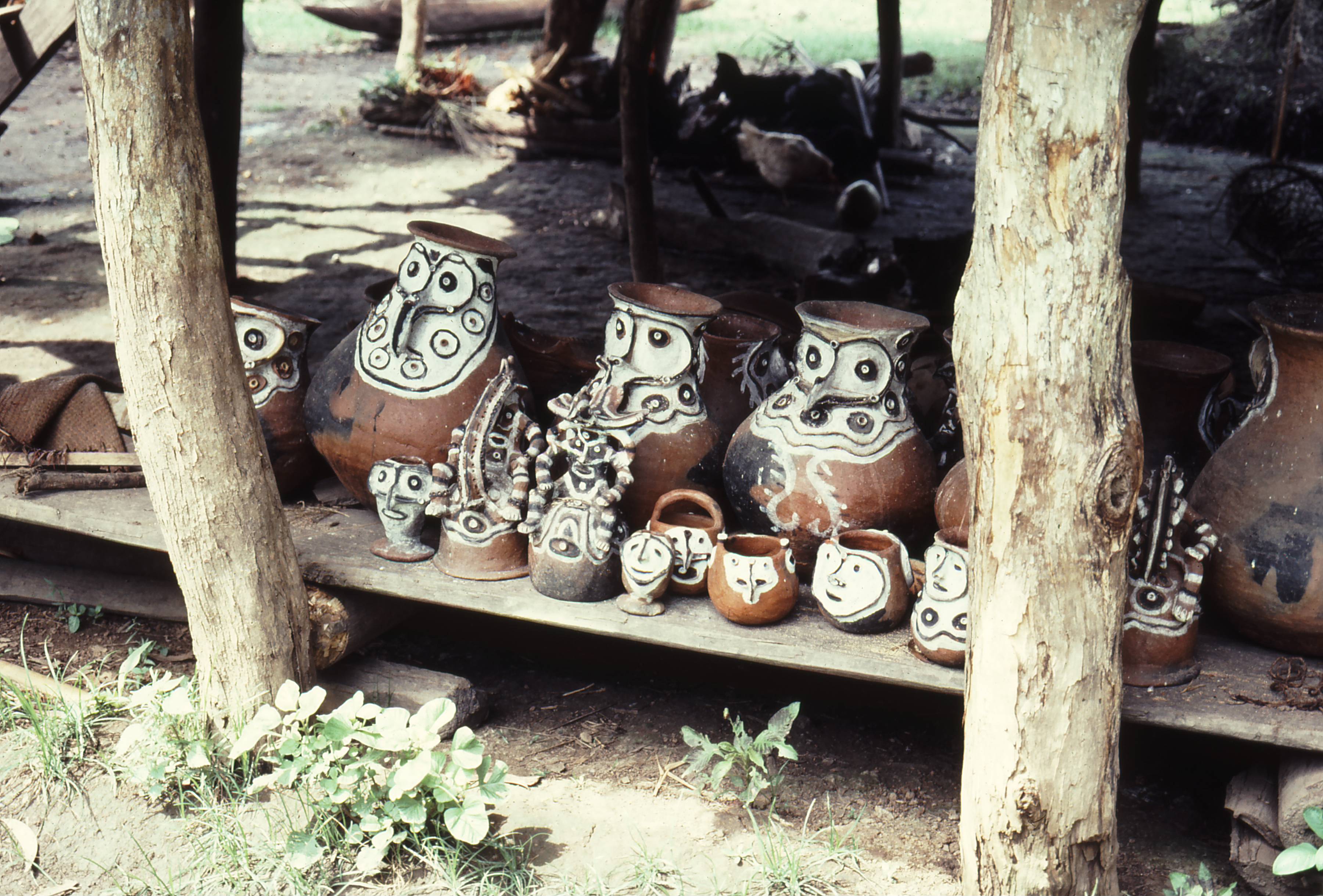 The Iatmul are the largest tribal group living along the Sepik. Their sculpture and paintings are renowned for their quality of craftsmanship. The works are unquestionably the finest produced in PNG. Art patrons have aggressively sought them since the first pieces began appearing on the market following World War II.
The Iatmul are the largest tribal group living along the Sepik. Their sculpture and paintings are renowned for their quality of craftsmanship. The works are unquestionably the finest produced in PNG. Art patrons have aggressively sought them since the first pieces began appearing on the market following World War II.
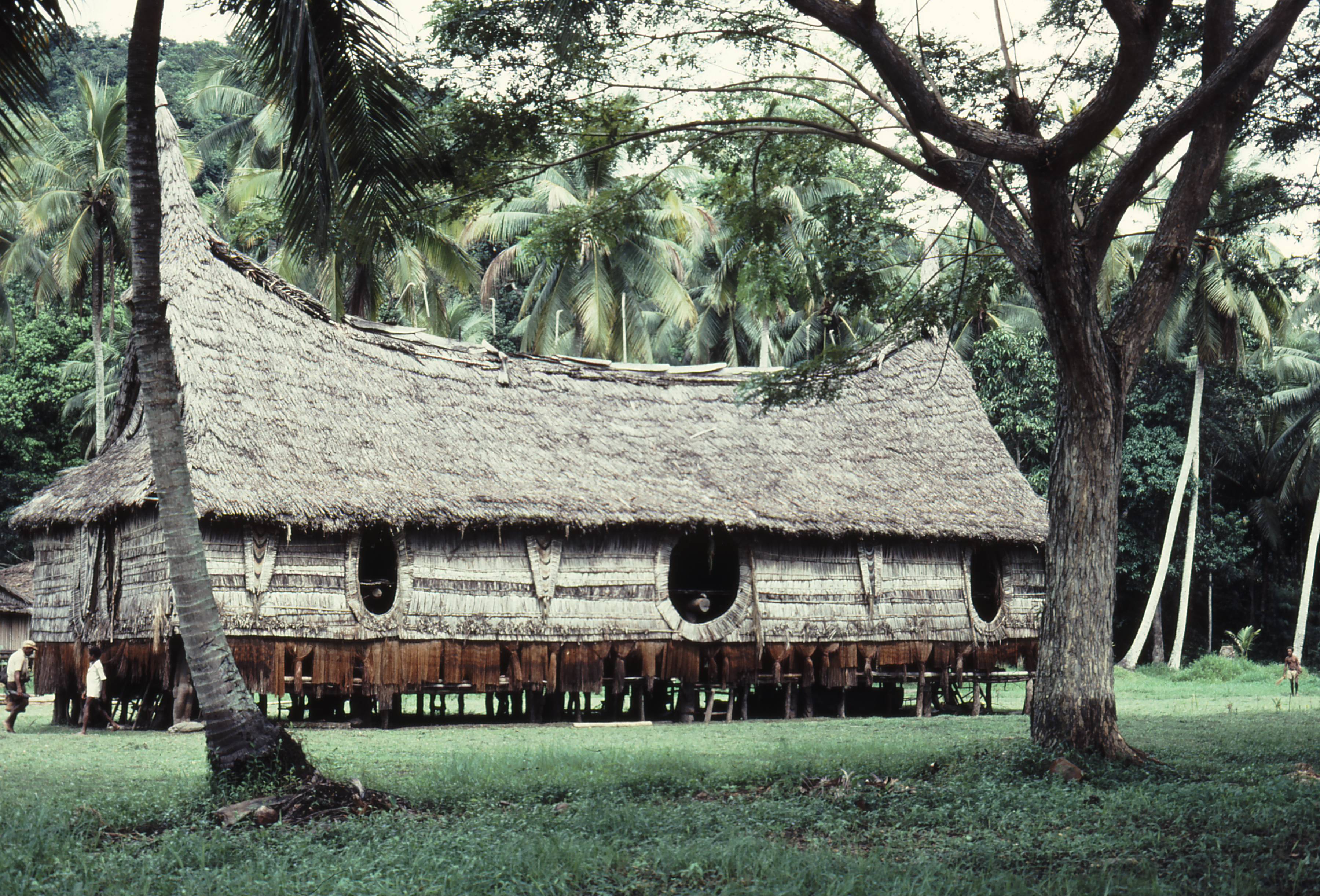 Their ceremonial houses, called long houses, are the grandest on the island. These structures are the center of Iatmul culture. They are the focus of village life. Elaborate and prolonged initiation practices, mortuary rites and mythical pageants and plays are held here.
Their ceremonial houses, called long houses, are the grandest on the island. These structures are the center of Iatmul culture. They are the focus of village life. Elaborate and prolonged initiation practices, mortuary rites and mythical pageants and plays are held here. 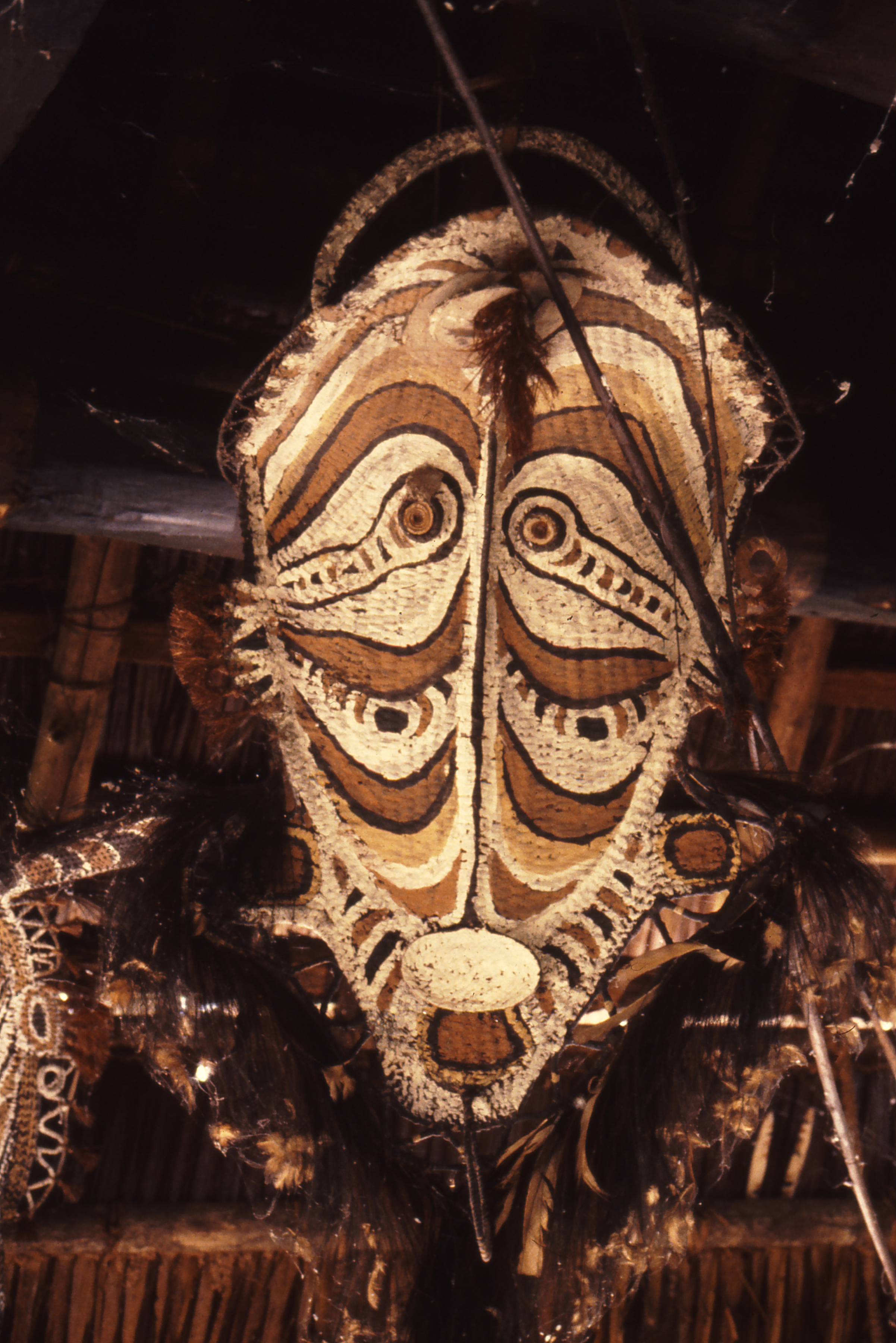 Every ceremony involves the use of elaborate masks, carved wooded figures of mythical beings, baskets, dancing male elders covered in paint and feathers and pigs – lots of pigs as they are the ultimate measure of wealth in this Stone Age bureaucracy. Headhunting is also an important part of many of these sacred rituals.
Every ceremony involves the use of elaborate masks, carved wooded figures of mythical beings, baskets, dancing male elders covered in paint and feathers and pigs – lots of pigs as they are the ultimate measure of wealth in this Stone Age bureaucracy. Headhunting is also an important part of many of these sacred rituals.
The Collector had carefully selected the Driver as his main man here because he was an Iatmul and had an inherent knowledge of Papuan art. One look at the hundreds of unemployed, malarial yellow-eyed idlers, known by the Caucasian population as Rascals, instantly told the Collector they totally lacked the basic intelligence to know the difference between a fine debating stool and a wooden stump. In this land of blind art aficionados, the one-eyed Iatmul were kings.
“What have you bought for me since the last trip?” asked the Collector as they drove the filthy, rutted streets of Moresby.
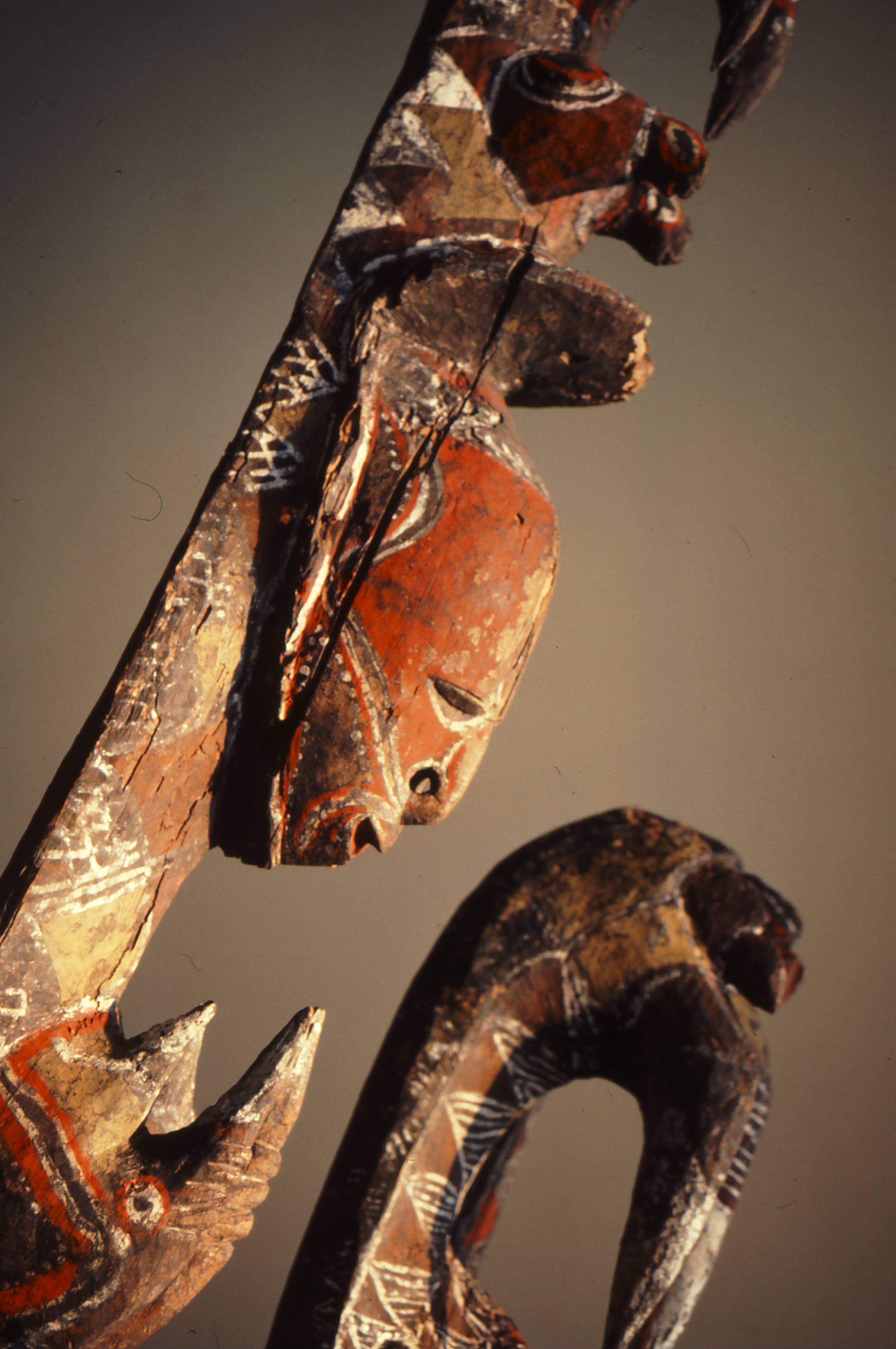 “Many things. Wonderful things. I know you will be proud to take them back to your rich, white clients in America” said the Driver. “They are at the warehouse. We can go see them now if you wish.”
“Many things. Wonderful things. I know you will be proud to take them back to your rich, white clients in America” said the Driver. “They are at the warehouse. We can go see them now if you wish.”
“No, it’s late. I’m extremely tired and in need of a bath and a very dry martini.”
“Ok, tomorrow then?”
“Certainly” said the Collector. He knew that the Driver’s taste in Sepik River artifacts was exquisite and only exceeded by his ability to purchase the pieces at rock bottom prices. For only a few kina, as Papuan currency is called, he could buy objects that sold for tens of thousands of dollars in San Francisco. Prior to the arrival of any form of currency, the natives placed great value on the gold-lipped pearl shell found in the waters of the Pacific Ocean and cut into crescent shapes called “kina”. It was only natural that they founded their monetary system on this ancient store of value.
The Range Rover approached the heavily fortified hotel. Every inch of the top of its 12-foot wall was covered in razor-sharp concertina wire. At the cardinal points four 18-foot tall towers containing a 30-caliber machine gun loomed menacingly above the dirt street below. Two huge Caucasian mercenaries carrying AK-15s with extended banana clips approached the vehicle. The Driver rolled down the window. The sentries quickly recognized the Collector and opened the gate. The Range Rover entered the courtyard and stopped at the bougainvillea-covered entry. The bellman bowed graciously to the Collector, opened the boot of the vehicle and retrieved the luggage. He knew from previous visits the suite the Collector preferred.
“What hour do you want me to pick you up in the morning?” asked the Driver.
“How about eight?” knowing Papuans had little concept of the Western idea of time.
“Have a pleasant rest,” said the Driver as he headed toward the exit gate.
The Collector walked toward the reception desk. A lovely brown-skinned girl, probably Thai, handed him a cold towel. “Thank you very much,” he said wiping his sweaty face.
“Welcome back, sir,” said the man behind the well-polished mahogany desk. “I took the liberty of sending your luggage ahead to your favorite suite. I hope that is acceptable. In addition a cold, very dry martini is on its way there also.”
“Excellent. I will be having dinner in the room tonight. Please send the usual and a half-bottle of Chateaux Margaux.”
“Certainly, Sir. I believe your bath water is being drawn as we speak and a silk robe has been laid out on the bed. Have a pleasant night. And ring if there is anything else we can do to make your stay in Moresby more pleasant.”
 The Collector laughed under his breath as he walked along the teak-lined corridors that lead to his suite. Nothing could make a stay in Moresby remotely pleasant, not even a magnum of Louis Roderer Cristal champagne and a night with the Thai girl who had given him the towel in the lobby.
The Collector laughed under his breath as he walked along the teak-lined corridors that lead to his suite. Nothing could make a stay in Moresby remotely pleasant, not even a magnum of Louis Roderer Cristal champagne and a night with the Thai girl who had given him the towel in the lobby.
He threw his filthy, sweat-stained clothes in the hamper and stepped into the marble tub. The martini sat on the ledge. He lit a Players. Taking a deep drag the Collector wondered if it was really worth all the trouble of coming here to buy Papuan art. After all, he had made more money than he could spend in several lifetimes. Maybe it was time to call it quits. But something, an obsession to find the most exotic chef d’oeuvre that his private collection lacked continued to drive him. Could this be the trip? He wondered as the warm water, gin and nicotine relaxed his taut muscles.
Dinner was fine, the wine well aged, the Thai silk robe comfortable and the sheets crisp and clean. He quickly fell into a deep sleep aided by the gentle whirring of the bamboo fan over the bed.
In Papua New Guinea you operate by the theory of natural light. Because of its location near the Equator the island receives about 12 hours of daylight and an equal amount of darkness every day. As a result the sun began filtering through the curtains of the Collector’s room about six. He rose, shaved, dressed and walked down to breakfast. “Just black coffee, fresh mango juice and a basket of pastries, please,” he told the waiter.
The Thai girl he had seen the previous night approached his table and said “There is an important message at the concierge for you, sir. It was delivered late last night. We did not want to wake you.”
“Would you bring it to me please?”
“Of course.”
She returned with a dirty envelope. He gave her a kina and said “Thank you.”
“My pleasure.”
He took a small Swiss Army knife out of his pocket and carefully slit open the envelope. On a small piece of wrinkled paper was a note. It said, “I have something you must see. Meet me at midnight at the usual place and come alone.” The note was signed the Merchant. His blood raced. It was uncommon for the Merchant to contact him unless he had something particularly unusual. The Merchant knew the Collector’s addiction to the exotic. He had fed the Collector’s habit for years.
The Collector tried to imagine what piece of esoterica the Merchant had acquired. The girl interrupted his reverie. “Your Driver has arrived.” Looking at his watch, he was pleasantly surprised; it was a few minutes past eight. He walked through the lobby to the waiting Land Rover.
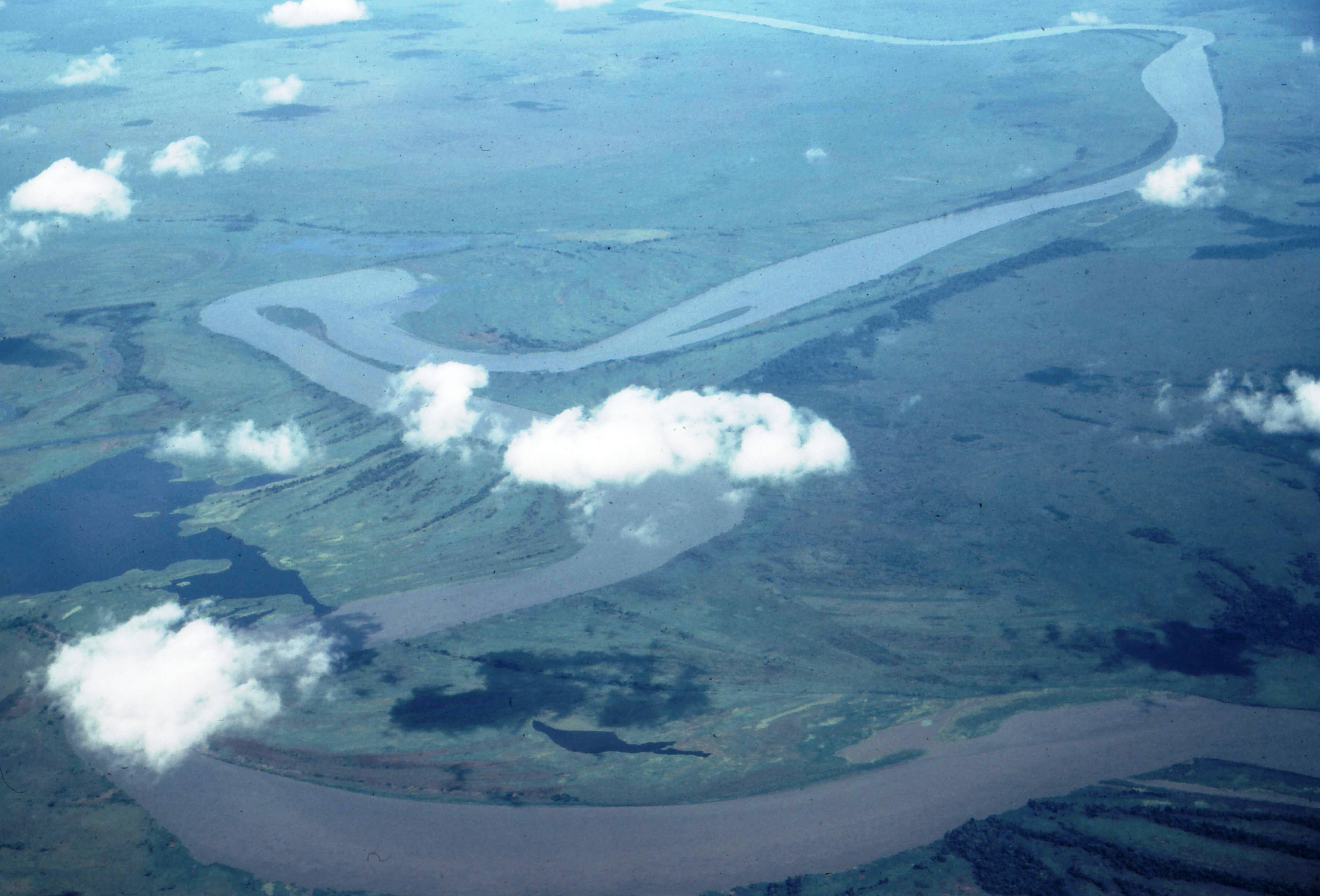 On the way to the warehouse the Collector inquired about the provenance of the objets d’art they would see. “Most of what I purchased this time came from the Middle Sepik River area.
On the way to the warehouse the Collector inquired about the provenance of the objets d’art they would see. “Most of what I purchased this time came from the Middle Sepik River area. 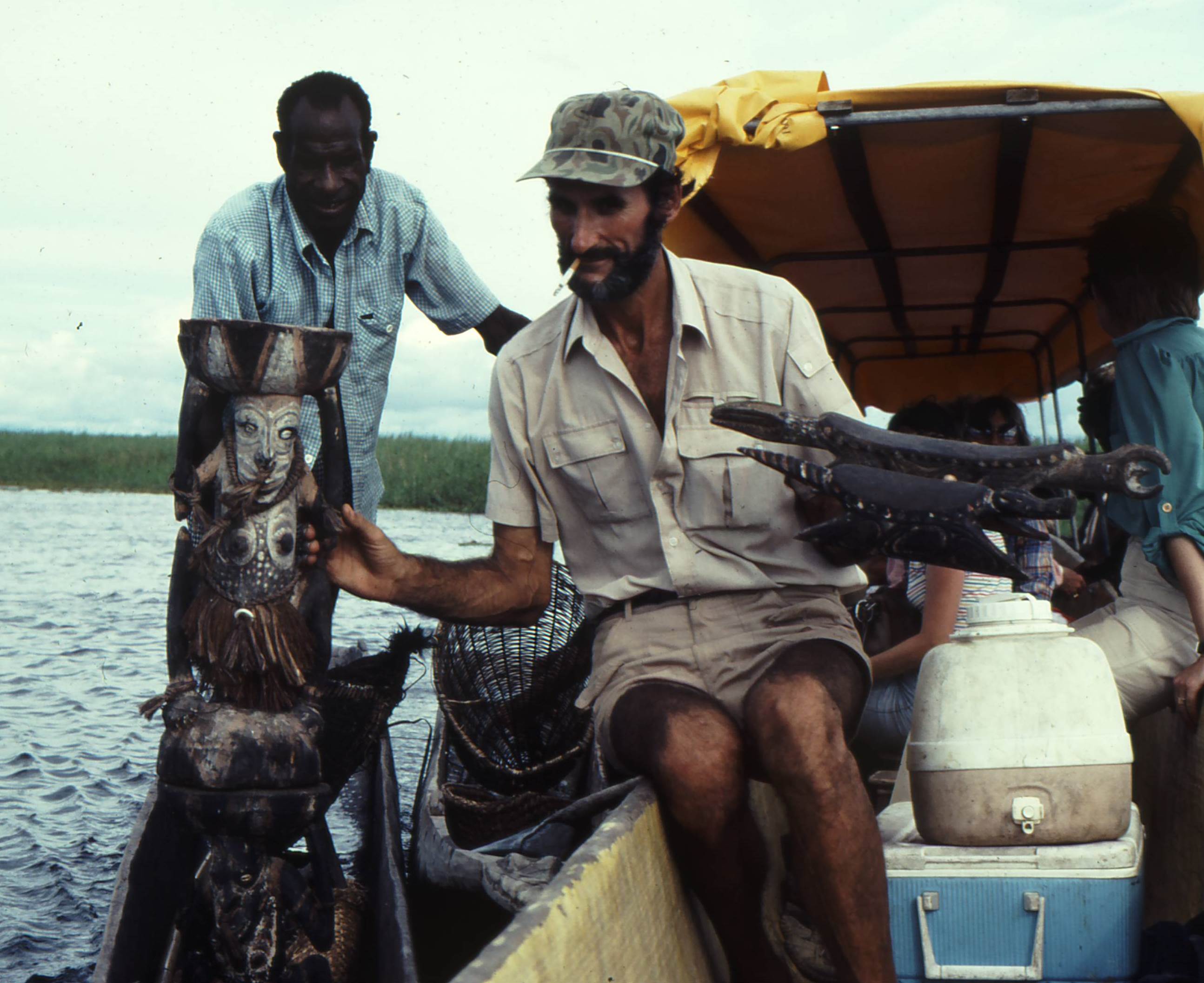 Some of the most interesting pieces came from the villages of Pagwi, Yentchan, Aibom, Kamindimbit, Tambanum, Angoram and a few from the people up the Karawari and Blackwater Rivers.” It was not surprising he did his trading here, as this was the homeland of the Iatmul. He would have known the best artists since childhood.
Some of the most interesting pieces came from the villages of Pagwi, Yentchan, Aibom, Kamindimbit, Tambanum, Angoram and a few from the people up the Karawari and Blackwater Rivers.” It was not surprising he did his trading here, as this was the homeland of the Iatmul. He would have known the best artists since childhood.
After about 20 minutes of driving through the boarded-up, burned-out, concertina-wired neighborhoods of Moresby, the Range Rover stopped in front of a well-fortified warehouse. Across the street a large gang of Rascals focused their indolent stares on the vehicle and its occupants. “Ignore them. It’s too early for them to have found enough whiskey to be dangerous,” said the Driver. A well-armed guard opened a steel door, admitting the visitors to the semi-darkness of the cavernous storehouse. The men walked back to a large, fenced-in area they leased from the Handicraft Development Branch of the Government of Papua New Guinea. It was here the Driver stored the purchases.
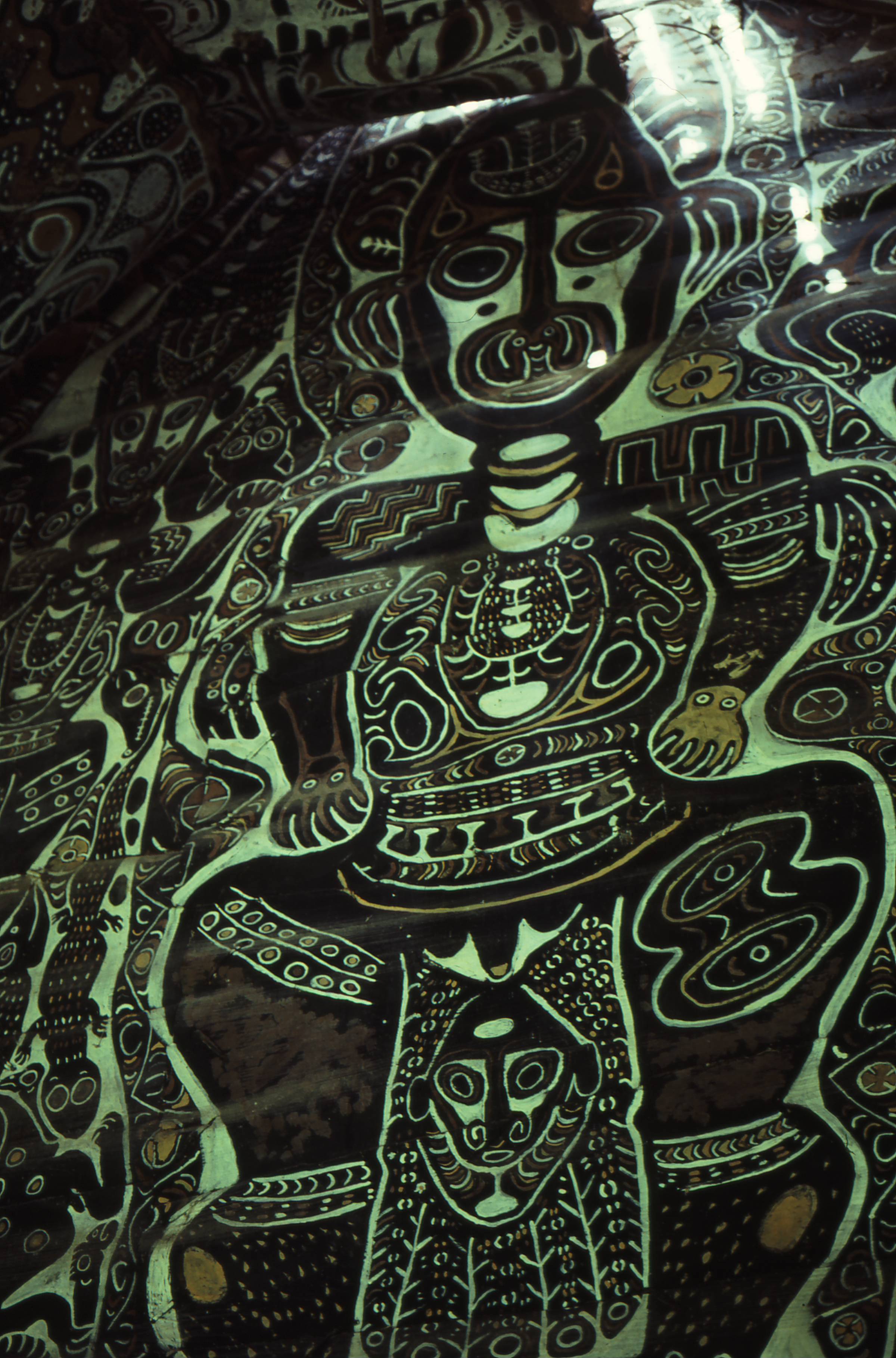 The Collector smiled. The Driver had done his usual job of acquiring the finest pieces of art the Sepik tribes had to offer. There were wooden carvings, clay pots and bark paintings produced by the most successful Washkuk headhunters; carved hornbills, helmet masks and fertility goddesses from the Abelam; wooden masks, ancestral figures and five-foot long shields made by the Angoram; Biwat flutes; oversized ancestral sculptures and ceremonial boards from the Sawos and debating stools, skulls covered in clay and paint, ceremonial dance carvings, suspension and cult hooks, erotic ritual objects, head rests and intricately carved crocodile head canoe prows from the Iatmul. “You did exceptionally well, my friend.” He offered the Driver a Players.
The Collector smiled. The Driver had done his usual job of acquiring the finest pieces of art the Sepik tribes had to offer. There were wooden carvings, clay pots and bark paintings produced by the most successful Washkuk headhunters; carved hornbills, helmet masks and fertility goddesses from the Abelam; wooden masks, ancestral figures and five-foot long shields made by the Angoram; Biwat flutes; oversized ancestral sculptures and ceremonial boards from the Sawos and debating stools, skulls covered in clay and paint, ceremonial dance carvings, suspension and cult hooks, erotic ritual objects, head rests and intricately carved crocodile head canoe prows from the Iatmul. “You did exceptionally well, my friend.” He offered the Driver a Players.
***
 The Anthropologist came to Papua New Guinea four years earlier. He was young, enthusiastic, highly intelligent and, most importantly, naive. Scion to one of the wealthiest Canadian families, he graduated with highest honors from McGill University in Montreal with a master’s degree. Scholars had been studying the anthropology of Canadian native people for more than one hundred years. Cases had been worked to the point of diminishing returns. He wanted to push the envelope in the field but more important he was in search of high adventure. He idolized Margaret Mead for her work with the Samoans and the Papuans and had read and reread her two classics in the field of anthropology, Coming of Age in Samoa (1925) and Growing up in New Guinea (1929). In addition he greatly admired Michael Rockefeller who mysteriously disappeared in New Guinea in 1961.
The Anthropologist came to Papua New Guinea four years earlier. He was young, enthusiastic, highly intelligent and, most importantly, naive. Scion to one of the wealthiest Canadian families, he graduated with highest honors from McGill University in Montreal with a master’s degree. Scholars had been studying the anthropology of Canadian native people for more than one hundred years. Cases had been worked to the point of diminishing returns. He wanted to push the envelope in the field but more important he was in search of high adventure. He idolized Margaret Mead for her work with the Samoans and the Papuans and had read and reread her two classics in the field of anthropology, Coming of Age in Samoa (1925) and Growing up in New Guinea (1929). In addition he greatly admired Michael Rockefeller who mysteriously disappeared in New Guinea in 1961.
Strangely enough, none of these factors led to his eventual demise. What did him in seems so insignificant in Western terms but was of paramount importance to the tribal people of New Guinea. His death was directly attributable to his love for hockey – specifically the Canadian Olympic hockey team.
His senior year in college these six overmatched, underrated athletes won the Olympic gold medal in hockey, defeating the vastly superior Soviet Union team 3-1 in one of the greatest upsets in sports history. He had tickets for the series and cheered loudly at every game. To celebrate the momentous victory he purchased a replica Canadian team jersey that he wore proudly. He never went anywhere without it, not even to the steaming jungles of New Guinea.
 The Western Judeo/Christian world and the Papuan/Animist/Mystical world both have an “eye-for-an-eye” philosophy. However, the perception of this belief is radically different. In the Holy Bible, Exodus 21:23-4 clearly states “But if there is serious injury, you are to take life for a life, eye for eye, tooth for tooth, hand for hand, foot for foot, burn for burn, wound for wound, bruise for bruise.” However, this rule was instituted as a guideline for judges to make the punishment fit the crime, not as a rule to justify revenge. In New Guinea the tribal people believe everything must be revenged. The authorities in Moresby estimate more than 100 revenge murders occur annually. Tribes keep accurate counts of transgressions by their adversaries and have very long memories that pass from generation to generation. It may take years but no offense goes unpunished. This practice is what doomed the Anthropologist.
The Western Judeo/Christian world and the Papuan/Animist/Mystical world both have an “eye-for-an-eye” philosophy. However, the perception of this belief is radically different. In the Holy Bible, Exodus 21:23-4 clearly states “But if there is serious injury, you are to take life for a life, eye for eye, tooth for tooth, hand for hand, foot for foot, burn for burn, wound for wound, bruise for bruise.” However, this rule was instituted as a guideline for judges to make the punishment fit the crime, not as a rule to justify revenge. In New Guinea the tribal people believe everything must be revenged. The authorities in Moresby estimate more than 100 revenge murders occur annually. Tribes keep accurate counts of transgressions by their adversaries and have very long memories that pass from generation to generation. It may take years but no offense goes unpunished. This practice is what doomed the Anthropologist.
A year before his arrival, an oilfield equipment truck was heading to a drilling location in southeast Papua New Guinea. This is the land of the Kukukuku, the fiercest individuals on the face of the earth. They are renowned for their warlike attitude, headhunting prowess, cannibalism and total disregard for human life – theirs or anyone else’s. While traversing a particularly slippery section of the muddy road, the truck veered uncontrollably, killing a Kukukuku warrior. Fearing trouble the man at the wheel sped off but not before the other members of the hunting party noted the Canadian license plate with its prominent red maple leaf design. There was now a death to revenge.
 Upon arriving in Port Moresby and against the strong advice of the local governor, the Anthropologist bought an old Toyota Land Cruiser and headed for the area inhabited by the Kukukuku. If you really want to live on the edge, this is about as close as you can come. He had lofty thoughts of new discoveries – understanding their customs, rites, sexual practices, beliefs, fears and inner thoughts. The Anthropologist saw himself a scientific pioneer ala Margaret Mead. The Kukukuku would see it differently.
Upon arriving in Port Moresby and against the strong advice of the local governor, the Anthropologist bought an old Toyota Land Cruiser and headed for the area inhabited by the Kukukuku. If you really want to live on the edge, this is about as close as you can come. He had lofty thoughts of new discoveries – understanding their customs, rites, sexual practices, beliefs, fears and inner thoughts. The Anthropologist saw himself a scientific pioneer ala Margaret Mead. The Kukukuku would see it differently.
It didn’t take the Kukukukus long to spot the old Land Rover. There was little vehicular traffic in this remote corner of the world. The sound of a diesel engine carried a long way in these mist filled valleys. At first it was idle curiosity that prompted the war party to approach the dirt highway. The Land Rover was almost crawling along in this terrain. The Anthropologist had taken the canvas top off the vehicle in order to soak up the beauty of this verdant jungle. He was wearing his beloved Canadian hockey jersey, now with the sleeves cut off in deference to the stifling heat and humidity of Papua New Guinea. The eagle-eyed natives immediately saw the bright red maple leaf on the breast of the jersey. Here, brazenly crossing their territory alone was a member of the tribe who had killed one of their own 12 months earlier. Time had come to settle that score.
The Anthropologist first saw the natives as he rounded a blind curve in the road. His heart raced – not from fear but excitement. Could these naked men be the famed Kukukuku he had come so far to study? There were seven of them lined up across the muddy highway. He came to a halt and jumped out of the vehicle. Glancing backwards he noted five more men had sealed off the road behind him.
 He walked toward a man with the largest feather headpiece, assuming he was a chief or tribal elder. He never had a chance to speak. The last thing the Anthropologist saw was an arrow rapidly approaching what had become a target on his chest – the bright red maple leaf on his hockey jersey. “Why?” he thought as he fell to the ground dead.
He walked toward a man with the largest feather headpiece, assuming he was a chief or tribal elder. He never had a chance to speak. The last thing the Anthropologist saw was an arrow rapidly approaching what had become a target on his chest – the bright red maple leaf on his hockey jersey. “Why?” he thought as he fell to the ground dead.
The Kukukuku warrior removed his arrow from the Anthropologist’s chest. They threw his body into a large bilum bag that was then hoisted up on a pole carried by two warriors. They disappeared into the thick jungle, leaving the Land Rover to be discovered weeks later by the next passerby who would wonder what it was doing abandoned so deep in Kukukuku territory. The warriors were ecstatic. Revenge was theirs. There would be a great celebration in the village. Drums would pound, notifying neighbors of the revenge killing. Pigs would be bled and then slaughtered. Everyone would gorge on the barely cooked meat, washing it down with copious amounts of porcine blood mixed with palm wine. The Anthropologist would have enjoyed this rite had he been alive to see it.
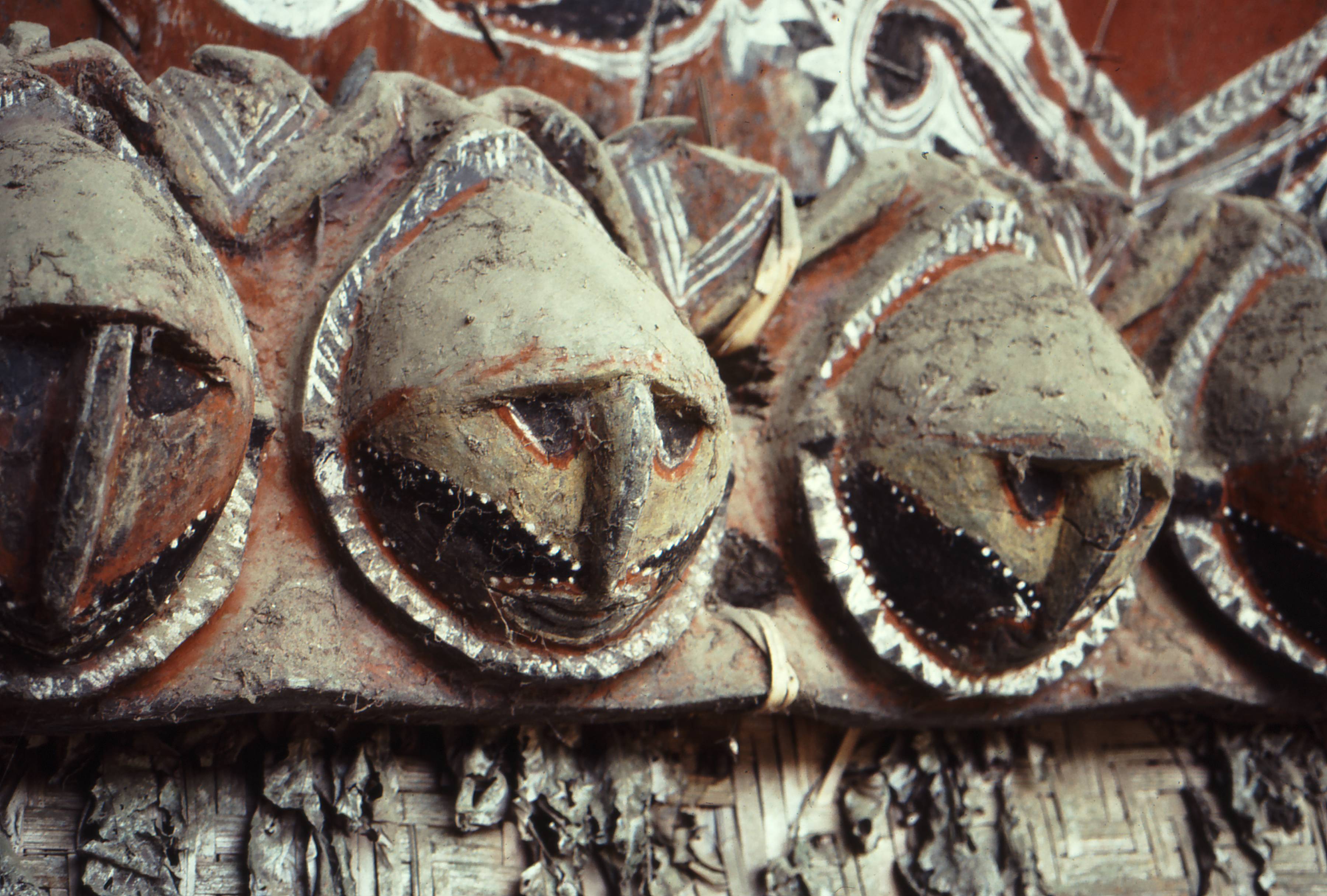 The body was eventually taken to the long house. It was here the elders would perform the sacred mortuary rights the headhunters reserved for such occasions. But this rite would be special because of the unusual nature of the enemy – his strangely pale, white skin, blue eyes, blond hair and thin lips. They had never seen such a being. The elders quickly decided this killing would bring especially powerful mystical blessings from the gods.
The body was eventually taken to the long house. It was here the elders would perform the sacred mortuary rights the headhunters reserved for such occasions. But this rite would be special because of the unusual nature of the enemy – his strangely pale, white skin, blue eyes, blond hair and thin lips. They had never seen such a being. The elders quickly decided this killing would bring especially powerful mystical blessings from the gods.
With the exception of the Kukukuku, all headhunters in New Guinea prepare the skulls of their victims in the same way. The head is severed from the torso with a swift swing of a stone ax. It is then hung outside the long house on a pole in order to drain the blood. Next it is placed in a large pot of boiling water in order to facilitate the flaying of the skin. A small incision is made in the rear of the skull and the brain is carefully removed and placed in a clay jar that is sealed with mud. An over molding of clay and oil is placed on the skull to approximate the facial structure of the victim. Village artists then decorate the dried clay base with paint in patterns that would have been worn by the victim. Other ornaments may be added such as seed pod beads or shells. Often, if their prize was a renowned headhunter in his own tribe, they will indicate the importance of this victory by crowning the skull with opossum fir – the Papuan sign of a great kill.
***
“Please arrange for a taxi to be here about half past eleven tonight,” said the Collector to the concierge. “And make certain the driver understands he is to wait for me while I visit a friend.”
“You are not going to use your regular driver?”
“Not tonight.”
“Very well, sir. I will arrange it.”
“Thank you.”
The Collector strolled into the comfortable, teak-paneled bar of the hotel and sat at a table in the corner. The Thai girl did not need to ask him what he wanted. She just nodded to the bartender who made a very dry gin martini.
“Good evening, sir. Here you are,” she said placing the drink on the table in front of him.
“Thank you.”
He watched her walk away. She had a pleasant gait, tiny hips gently swaying from side to side under her sarong. But tonight his obsession was not with lithe Asian beauties but rather with the anticipated meeting with the Merchant. He lit a Players, exhaling the smoke slowly.
The Collector looked at his watch. It was 11:00 PM. The girl brought him another martini. He opened the sterling silver case and took out another cigarette. The minutes ticked by.
“Sir, you car is here,” said the concierge.
“Very well.” He finished his drink and walked to the porte-cochere where the taxi was waiting.
“Take me to Waigani Street. I will tell you where to stop.”
“Yu betchum Bosman. Me sabe,” said the taxi driver in Pidgin English, a perverted language developed by the Papuans during World War II. The man revved the jalopy’s engine and headed for the gate that was opened by one of the well-armed Caucasians and then quickly slammed shut.
They bounced through the darkened and rutted streets of Port Moresby. A few minutes before midnight the taxi turned on to Waigani. About 100 meters down the street was a narrow alley. “Stop here and wait for me,” said the Collector. He failed to see the ragged urchin watching him from the darkness. As the Collector disappeared into the alley, the boy followed him at a safe distance and saw him knock on the door of a small shop. A voice from inside said, “Is that you?”
He said, “Yes,” and the door opened. He entered.
“Welcome, my friend,” said the Merchant, “have a seat. Would you like something to drink? Coffee, tea or beer, perhaps?”
“No, nothing. Let’s get down to business. Show me what you have.”
The Merchant took a small bilum bag from his desk and handed it his client. Very carefully the Collector removed the grapefruit-sized object from the bag and unwrapped the pandanus leaves that encased it. The Merchant smiled broadly when he saw the look of astonishment on the Collector’s face. “It’s, it’s…incredible. I’ve never seen anything like it. Where did you get it?” asked the Collector, looking at the leathery head of the Anthropologist.
“It has a very interesting provenance. Would you like to hear the story, my friend?”
“Yes, of course.” The Collector lit a Players and offered one to his companion as he studied the head closely.
“You are familiar with the Kukukukus, correct?”
“I am,” said the Collector, “but it is very rare to see anything from them. The Driver may have purchased half a dozen objets d’ art from them since I hired him years ago. But never anything like this.”
“No wonder. This is one of a kind. It is the head of a white man and is preserved in their unique style. No other tribal group cures trophy heads in this manner. An outcast Kukukuku stole this from the village long house, hoping to sell it for whiskey kina. Someone sent him to me last week.” The Merchant went on to relay the story of the revenge killing of the Anthropologist. “You see, the Kukukuku smoke the heads of their enemies. Five or six days after death, the head is severed and placed on a small platform under which is a small fire. For the first week the fire is kept burning day and night. Then it will be lit every third day. The heat causes the skin to blister. The elders rub the skin with bark, taking care not to allow anything to drop on the ground or the spirit of the dead man will haunt the village. The head gradually swells up from the heat. To prevent it from bursting, hollow bamboo sticks are inserted into it to release any fluids. As these drain tubes fill up they are placed on banana leaves, again to prevent the spirit from touching the ground. After about ten weeks the process is complete. The head is the leathery texture you feel now and, as you can see, it is about half the size of a normal skull.”
“What is your price?” the Collector asked.
“15,000 kina.” The Collector quickly calculated the exchange rate value. The Merchant was asking about $50,000 U. S. dollars.
“A fair price, considering its uniqueness.” He took a draft out of his pocket and made it payable to the Merchant who said, “It is always a pleasure doing business with you, my friend.”
“I must go now. I have a taxi waiting for me on Waigani Street.” He wanted to return to the safety of his hotel. He carefully rewrapped the head in the pandanus leaves and returned it to the bilum bag. They walked to the door of the shop, shook hands and parted ways. The Merchant smiled. With 15,000 kina he was a very wealthy man in PNG.
The Collector stepped back into the dark alley and turned toward the waiting taxi. He was anxious to return to his suite to examine this treasure in great detail. He said to himself, “At last I have it, the crown jewel of my collection. I’ll never have to set foot in this God-forsaken hell hole again.” It was the last thought he would ever have. The steel hatchet plunged deep into his cranium, killing him instantly. The Rascal wielding it had no recollection of the trade he made with the white man on a jungle trail years earlier when they exchanged axes. His mission was to grab the bilum bag and run. His gang needed money for whiskey and cigarettes and the Leader had been told by the urchin that the white man was in the shop.
 At the end of the alley he met his mates. The Leader said “Yu givum me da bilum.”
At the end of the alley he met his mates. The Leader said “Yu givum me da bilum.”
“Ya Bosman.”
The Leader carefully removed the object from the bilum bag and unwrapped the dried pandanus leaves. He looked with disgust at the skull and then at the Rascal who had killed the Collector. “Dis no worth nutin. Yu sabe? Yu gotta bringum me somding for whiskey kina, sabe?” he said as he tossed the Anthropologist’s head in a pile of trash and walked away.

